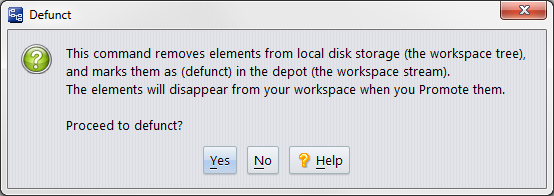The Defunct command removes elements from active use in your workspace. That is, for each element you specify, it:
|
•
|
marks the element as (defunct) in the workspace stream
|
Operating system commands won't find a defunct element (because it really is gone from the workspace tree), but the File Browser can see the element in your workspace stream, where it is both (defunct) and a (member).
Defunct does not remove an element from the depot altogether (no operation removes an element altogether -- that would violate AccuRev's TimeSafe property). And it does not make an element disappear for all users. Defunct just removes an element from a particular workspace. The element remains visible in other streams and workspaces -- at least until you Promote it.
In the Details pane of a File Browser that is open on a workspace, select one or more file elements. Then right-click the selection and choose Defunct from the context menu.
The Defunct dialog appears, prompting you to confirm your intention to remove the element(s).
If any of the elements you specify is a directory, Defunct works recursively: it removes the directory itself and elements under that directory. Only the specified directory itself becomes (defunct); the objects below it are simply removed from the workspace tree, but do not become (defunct) in the workspace stream.
The precise result depends on whether any elements located below the defuncted directory are active:
|
•
|
If one or more elements below the defuncted directory is active, those elements become stranded. A stranded element is not removed from your workspace tree, but its status becomes (external), since the workspace stream no longer has a valid pathname to the object.
|
Caution: In all cases of defuncting a directory, a file below the defuncted directory that you have edited -- but never preserved with Keep -- will be removed from the workspace tree. (Such files are not officially "active" in the workspace.) This removes data for which there might be no other copy.
After defuncting an element, you use Promote to propagate its removal to your workspace's backing stream. The element won't appear in a File Browser that is open on your workspace, but it will appear, with (defunct) status, in a File Browser that is open on the backing stream.
You can usually recover the backed version of the (defunct) element by invoking the Revert to Basis command on it. However, if either of the following conditions apply, the correct way to recover the version is to invoke the accurev undefunct command from the CLI.
|
•
|
If you have kept changes in your workspace before defuncting. Remember that if you Revert to Basis an element which has not been promoted, you eliminate the version of that element in your workspace.
|
|
•
|
If you have promoted the (defunct) element, so that it no longer appears in the File Browser.
|
When a user in a sibling workspace performs an Update, the element will disappear from that workspace.
With each successive promotion up the stream hierarchy, a defunct element disappears from the source ("promote from") stream, and becomes active, with (defunct) status, in the destination ("promote to") stream.
